2021 HONDA CLARITY FUEL CELL power steering
[x] Cancel search: power steeringPage 420 of 555
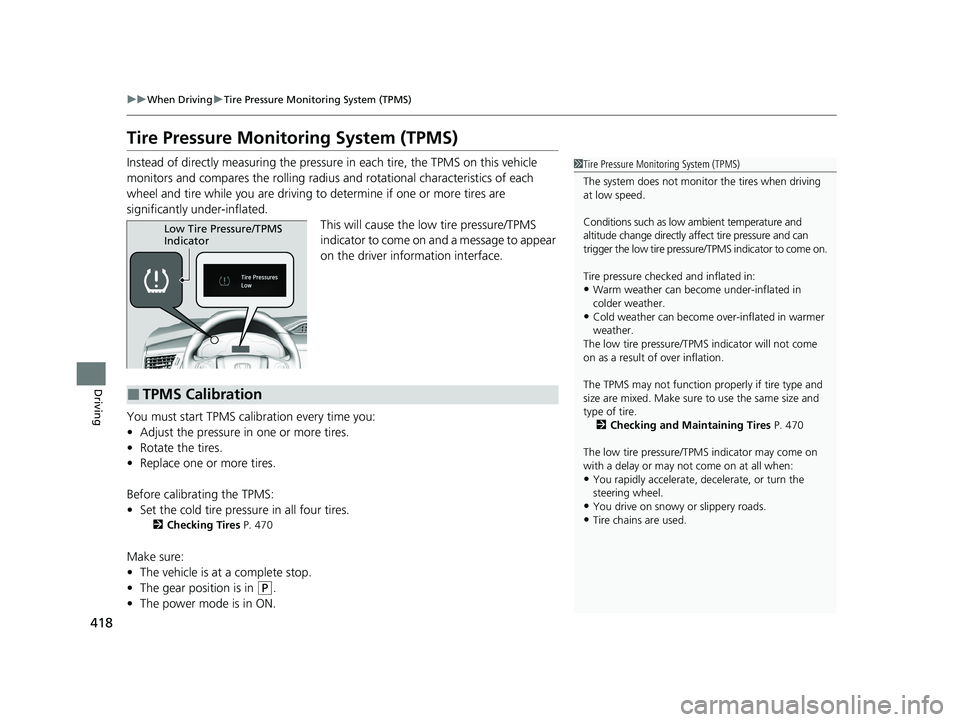
418
uuWhen Driving uTire Pressure Monitoring System (TPMS)
Driving
Tire Pressure Monitoring System (TPMS)
Instead of directly measuring the pressu re in each tire, the TPMS on this vehicle
monitors and compares the rolling radius and rotational characteristics of each
wheel and tire while you are driving to determine if one or more tires are
significantly under-inflated.
This will cause the low tire pressure/TPMS
indicator to come on and a message to appear
on the driver information interface.
You must start TPMS calibration every time you:
• Adjust the pressure in one or more tires.
• Rotate the tires.
• Replace one or more tires.
Before calibrating the TPMS:
• Set the cold tire pressu re in all four tires.
2Checking Tires P. 470
Make sure:
•The vehicle is at a complete stop.
• The gear position is in
(P.
• The power mode is in ON.
1Tire Pressure Monitoring System (TPMS)
The system does not monitor the tires when driving
at low speed.
Conditions such as low ambient temperature and
altitude change directly a ffect tire pressure and can
trigger the low tire pressure/TPMS indicator to come on.
Tire pressure checked and inflated in:
•Warm weather can beco me under-inflated in
colder weather.
•Cold weather can become over-inflated in warmer
weather.
The low tire pressure/TPMS indicator will not come
on as a result of over inflation.
The TPMS may not function pr operly if tire type and
size are mixed. Make sure to use the same size and
type of tire. 2 Checking and Maintaining Tires P. 470
The low tire pressure/TPMS indicator may come on
with a delay or may not come on at all when:
•You rapidly accelerate, decelerate, or turn the
steering wheel.
•You drive on snowy or slippery roads.
•Tire chains are used.
Low Tire Pressure/TPMS
Indicator
■TPMS Calibration
21 CLARITY FCV CSS-31TRT6400_02.book 418 ページ 2020年9月25日 金曜日 午 後3時15分
Page 432 of 555
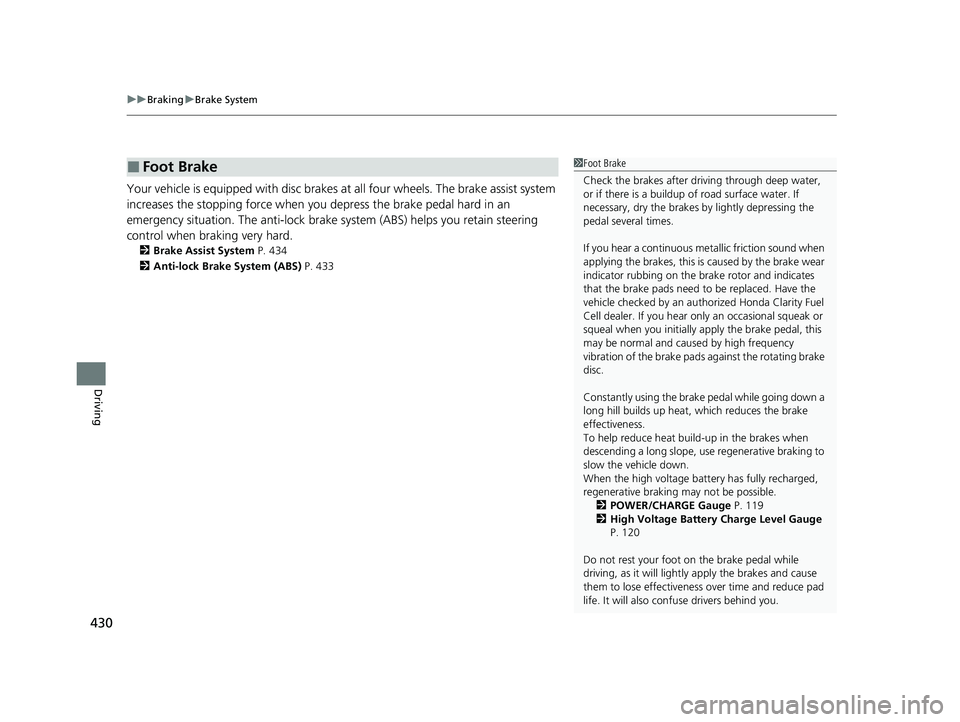
uuBraking uBrake System
430
Driving
Your vehicle is equipped with disc brakes at all four wh eels. The brake assist system
increases the stopping force when you depress the brake pedal hard in an
emergency situation. The an ti-lock brake system (ABS) helps you retain steering
control when braking very hard.
2 Brake Assist System P. 434
2 Anti-lock Brake System (ABS) P. 433
■Foot Brake1Foot Brake
Check the brakes after driving through deep water,
or if there is a buildup of road surface water. If
necessary, dry the brakes by lightly depressing the
pedal several times.
If you hear a continuous me tallic friction sound when
applying the brakes, this is caused by the brake wear
indicator rubbing on the brake rotor and indicates
that the brake pads need to be replaced. Have the
vehicle checked by an authorized Honda Clarity Fuel
Cell dealer. If you hear onl y an occasional squeak or
squeal when you initially a pply the brake pedal, this
may be normal and caus ed by high frequency
vibration of the brake pads against the rotating brake
disc.
Constantly using the brake pedal while going down a
long hill builds up heat, which reduces the brake
effectiveness.
To help reduce heat build -up in the brakes when
descending a long slope, use regenerative braking to
slow the vehicle down.
When the high voltage battery has fully recharged,
regenerative braking may not be possible.
2 POWER/CHARGE Gauge P. 119
2 High Voltage Battery Charge Level Gauge
P. 120
Do not rest your foot on the brake pedal while
driving, as it will lightly apply the brakes and cause
them to lose effectiveness over time and reduce pad
life. It will also conf use drivers behind you.
21 CLARITY FCV CSS-31TRT6400_02.book 430 ページ 2020年9月25日 金曜日 午 後3時15分
Page 435 of 555
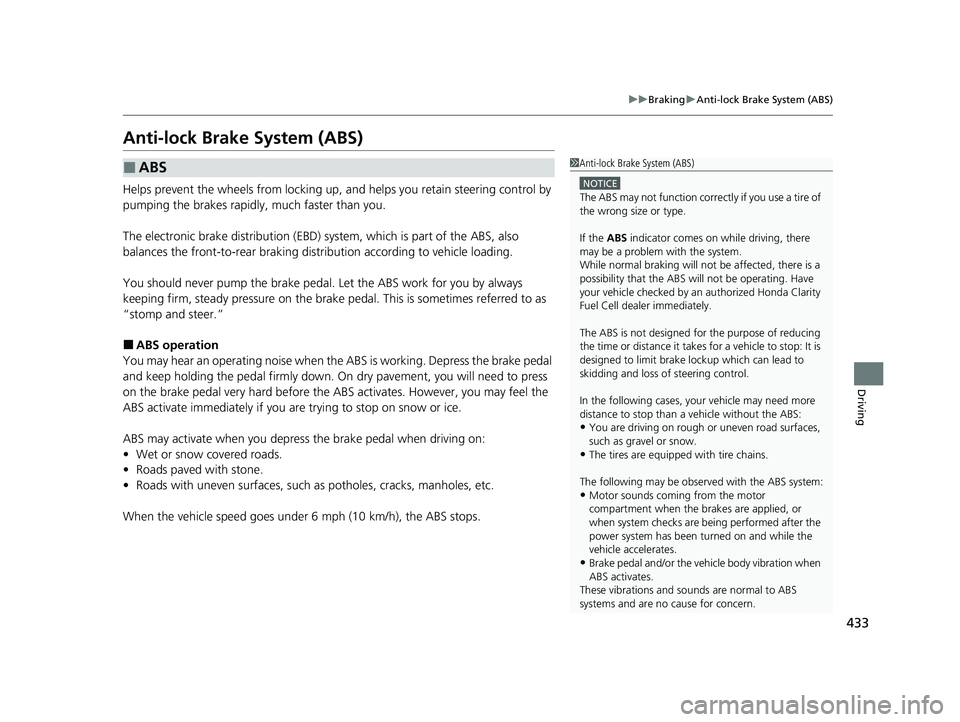
433
uuBraking uAnti-lock Brake System (ABS)
Driving
Anti-lock Brake System (ABS)
Helps prevent the wheels from locking up, and helps you retain steering control by
pumping the brakes rapidly, much faster than you.
The electronic brake distribu tion (EBD) system, which is part of the ABS, also
balances the front-to-rear braking distribution according to vehicle loading.
You should never pu mp the brake pedal. Let the ABS work for you by always
keeping firm, steady pressure on the brake pe dal. This is sometimes referred to as
“stomp and steer.”
■ABS operation
You may hear an operating noise when th e ABS is working. Depress the brake pedal
and keep holding the pedal firmly down. On dry pavement, you will need to press
on the brake pedal very hard before the AB S activates. However, you may feel the
ABS activate immediately if you are trying to stop on snow or ice.
ABS may activate when you depres s the brake pedal when driving on:
• Wet or snow covered roads.
• Roads paved with stone.
• Roads with uneven surf aces, such as potholes, cracks, manholes, etc.
When the vehicle speed goes unde r 6 mph (10 km/h), the ABS stops.
■ABS1Anti-lock Brake System (ABS)
NOTICE
The ABS may not function correctly if you use a tire of
the wrong size or type.
If the ABS indicator comes on while driving, there
may be a problem with the system.
While normal braking will not be affected, there is a
possibility that the ABS wi ll not be operating. Have
your vehicle checked by an authorized Honda Clarity
Fuel Cell dealer immediately.
The ABS is not designed for the purpose of reducing
the time or distance it takes for a vehicle to stop: It is
designed to limit brake lockup which can lead to
skidding and loss of steering control.
In the following cases, yo ur vehicle may need more
distance to stop than a vehicle without the ABS:
•You are driving on rough or uneven road surfaces,
such as gravel or snow.
•The tires are equipped with tire chains.
The following may be observed with the ABS system:
•Motor sounds coming from the motor
compartment when the brakes are applied, or
when system checks are being performed after the
power system has been turned on and while the
vehicle accelerates.
•Brake pedal and/or the vehicle body vibration when
ABS activates.
These vibrations and sou nds are normal to ABS
systems and are no cause for concern.
21 CLARITY FCV CSS-31TRT6400_02.book 433 ページ 2020年9月25日 金曜日 午 後3時15分
Page 438 of 555
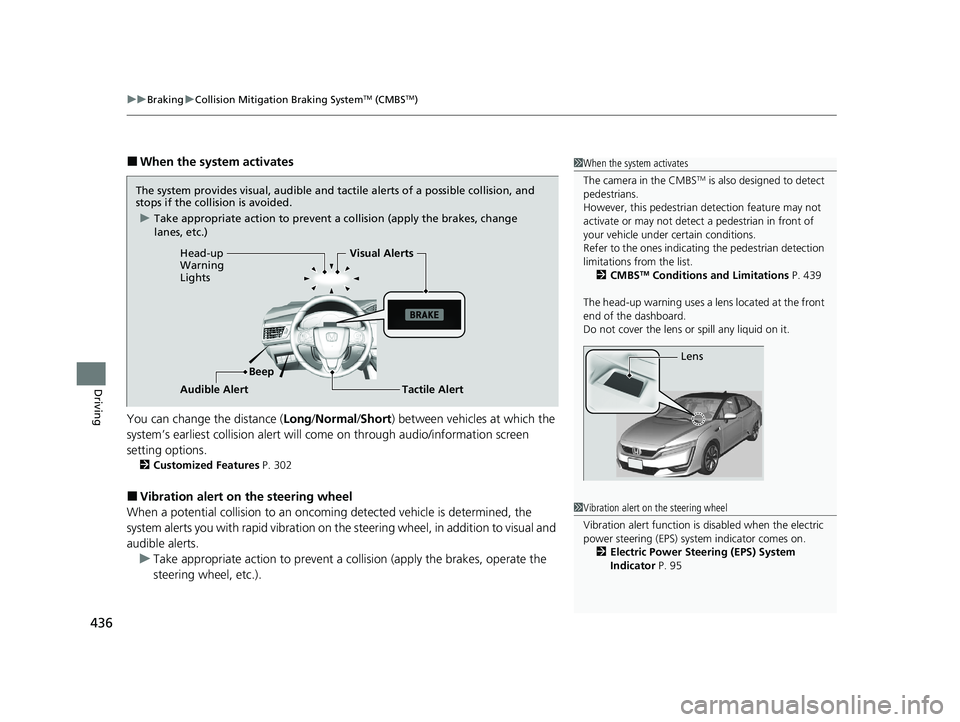
uuBraking uCollision Mitigation Braking SystemTM (CMBSTM)
436
Driving
■When the system activates
You can change the distance ( Long/Normal /Short ) between vehicles at which the
system’s earliest collision alert will co me on through audio/information screen
setting options.
2 Customized Features P. 302
■Vibration alert on the steering wheel
When a potential collision to an oncoming detected vehicle is determined, the
system alerts you with rapid vibration on the steering wheel, in addition to visual and
audible alerts. u Take appropriate action to prevent a co llision (apply the brakes, operate the
steering wheel, etc.).
1 When the system activates
The camera in the CMBS
TM is also designed to detect
pedestrians.
However, this pedestrian detection feature may not
activate or may not detect a pedestrian in front of
your vehicle under certain conditions.
Refer to the ones indicating the pedestrian detection
limitations from the list. 2 CMBS
TM Conditions and Limitations P. 439
The head-up warning uses a lens located at the front
end of the dashboard.
Do not cover the lens or spill any liquid on it.
Lens
The system provides visual, audible and tactile alerts of a possible collision, and
stops if the collision is avoided.
u Take appropriate action to prevent a collision (apply the brakes, change
lanes, etc.)
Beep
Head-up
Warning
Lights
Visual Alerts
Audible Alert
Tactile Alert
1 Vibration alert on the steering wheel
Vibration alert function is disabled when the electric
power steering (EPS) system indicator comes on. 2 Electric Power Steering (EPS) System
Indicator P. 95
21 CLARITY FCV CSS-31TRT6400_02.book 436 ページ 2020年9月25日 金曜日 午 後3時15分
Page 459 of 555
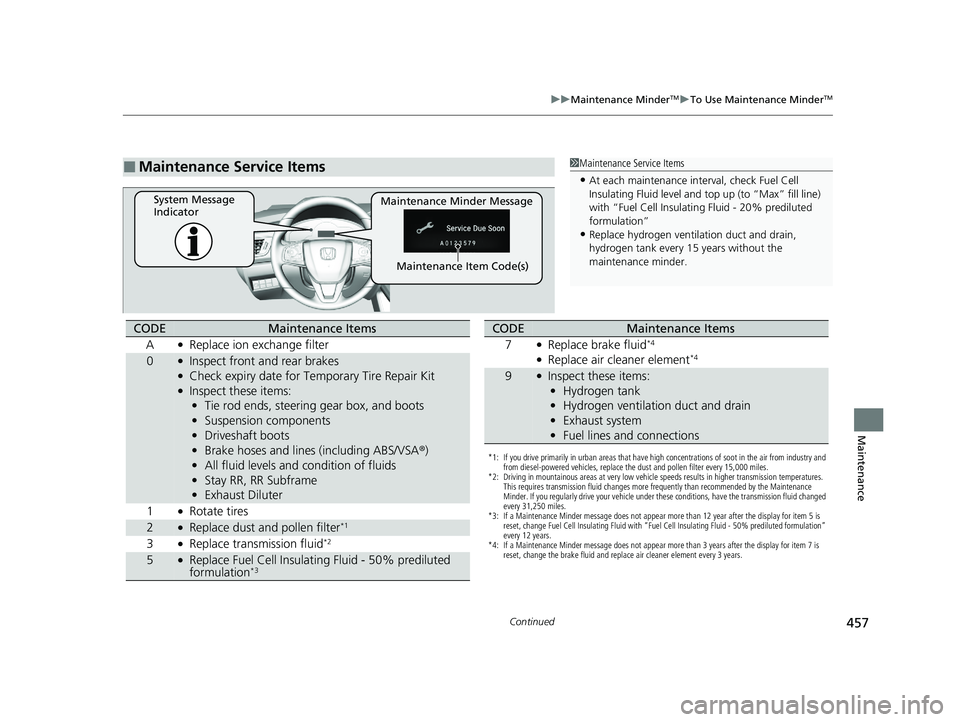
457
uuMaintenance MinderTMuTo Use Maintenance MinderTM
Continued
Maintenance
■Maintenance Service Items1Maintenance Service Items
•At each maintenance interval, check Fuel Cell
Insulating Fluid level and top up (to “Max” fill line)
with “Fuel Cell Insulating Fluid - 20% prediluted
formulation”
•Replace hydrogen ventil ation duct and drain,
hydrogen tank every 15 years without the
maintenance minder.
Maintenance Minder Message
System Message
Indicator
Maintenance Item Code(s)
CODEMaintenance Items
A
●Replace ion exchange filter
0●Inspect front and rear brakes●Check expiry date for Temporary Tire Repair Kit●Inspect these items: • Tie rod ends, steering gear box, and boots
• Suspension components
• Driveshaft boots
• Brake hoses and lines (including ABS/VSA ®)
• All fluid levels and condition of fluids
• Stay RR, RR Subframe
• Exhaust Diluter
1
●Rotate tires
2●Replace dust and pollen filter*1
3●Replace transmission fluid*2
5●Replace Fuel Cell Insulati ng Fluid - 50% prediluted
formulation*3
*1: If you drive primarily in urban areas that have high concentrations of soot in the air from industry and
from diesel-powered vehicles, replace the dust and pollen filter every 15,000 miles.
*2: Driving in mountainous areas at very low vehicle speeds results in higher transmission temperatures. This requires transmission fluid changes more frequently than recommended by the Maintenance
Minder. If you regularly drive your vehicle under these conditions, have the transmission fluid changed
every 31,250 miles.
*3: If a Maintenance Minder message does not appear more than 12 year after the display for item 5 is reset, change Fuel Cell Insulating Fluid with “Fuel Cell Insulating Fluid - 50% prediluted formulation”
every 12 years.
*4: If a Maintenance Minder message does not appear more than 3 years after the display for item 7 is reset, change the brake fluid and replace air cleaner element every 3 years.
CODEMaintenance Items
7
●Replace brake fluid*4
●Replace air cleaner element*4
9●Inspect these items: • Hydrogen tank
• Hydrogen ventilation duct and drain
• Exhaust system
• Fuel lines and connections
21 CLARITY FCV CSS-31TRT6400_02.book 457 ページ 2020年9月25日 金曜日 午 後3時15分
Page 493 of 555

491
Handling the Unexpected
This chapter explains how to handle unexpected troubles.
If a Tire Goes FlatTemporarily Repairi ng a Flat Tire....... 492
Handling of the Jack ......................... 504
Power System Won’t Start Checking the Procedure ................... 505
If the Smart Entry Remote Battery is Weak .......................................... 506
Emergency Power System Off........... 507
If the 12-Volt Battery Is Dead .......... 508
Overheating How to Handle Overheating ............. 511
If Hydrogen Gas is Leaking .............. 513Indicator, Coming On/Blinking
If the 12-Volt Battery Charging System Indicator Comes On ....................... 515
If the Brake System Indicator (Red) Comes On or Blinks ....................................... 516
If the Electric Power Steering (EPS) System Indicator Comes On ........................... 516If the Brake System Indicator (Red) Comes On or Blinks at the Same Time
When the Brake System Indicator
(Amber) Comes On ...................... 517
If the Low Tire Pressure/TPMS Indicator
Comes On or Blinks ....................... 518
If the Transmission System Indicator Blinks along with the Warning Message .... 519
Fuses Fuse Locations ................................. 520
Inspecting and Changing Fuses ........ 527
Emergency Towing ........................... 528
If You Cannot Unlock the Hydrogen Fuel Lid ...................................................... 529
If You Cannot Open the Trunk ........ 530
21 CLARITY FCV CSS-31TRT6400_02.book 491 ページ 2020年9月25日 金曜日 午 後3時15分
Page 494 of 555
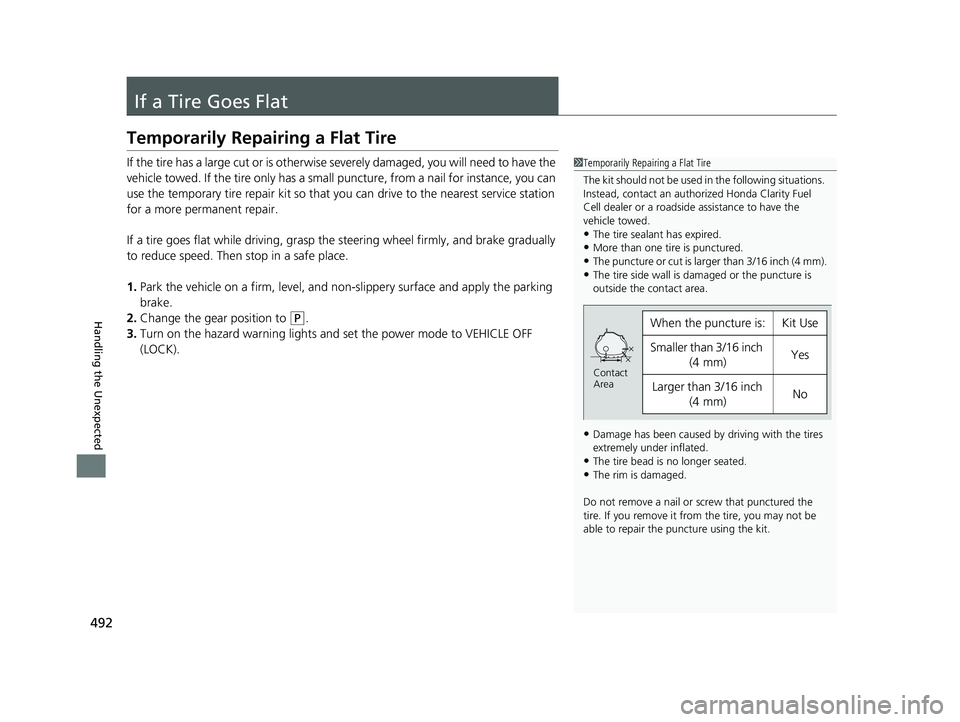
492
Handling the Unexpected
If a Tire Goes Flat
Temporarily Repairing a Flat Tire
If the tire has a large cut or is otherwise severely damaged, you will need to have the
vehicle towed. If the tire only has a smal l puncture, from a nail for instance, you can
use the temporary tire repair kit so that you can drive to the nearest service station
for a more permanent repair.
If a tire goes flat while driving, grasp the steering wheel firmly, and brake gradually
to reduce speed. Then stop in a safe place.
1. Park the vehicle on a firm, level, and non-slippery surface and apply the parking
brake.
2. Change the gear position to
(P.
3. Turn on the hazard warning lights an d set the power mode to VEHICLE OFF
(LOCK).
1 Temporarily Repairing a Flat Tire
The kit should not be used in the following situations.
Instead, contact an authorized Honda Clarity Fuel
Cell dealer or a roadside assistance to have the
vehicle towed.
•The tire sealant has expired.•More than one tire is punctured.
•The puncture or cut is larger than 3/16 inch (4 mm).
•The tire side wall is da maged or the puncture is
outside the contact area.
•Damage has been caused by driving with the tires
extremely under inflated.
•The tire bead is no longer seated.•The rim is damaged.
Do not remove a nail or screw that punctured the
tire. If you remove it from the tire, you may not be
able to repair the puncture using the kit.
When the puncture is:Kit Use
Smaller than 3/16 inch (4 mm)Yes
Larger than 3/16 inch
(4 mm)No
Contact
Area
21 CLARITY FCV CSS-31TRT6400_02.book 492 ページ 2020年9月25日 金曜日 午 後3時15分
Page 509 of 555
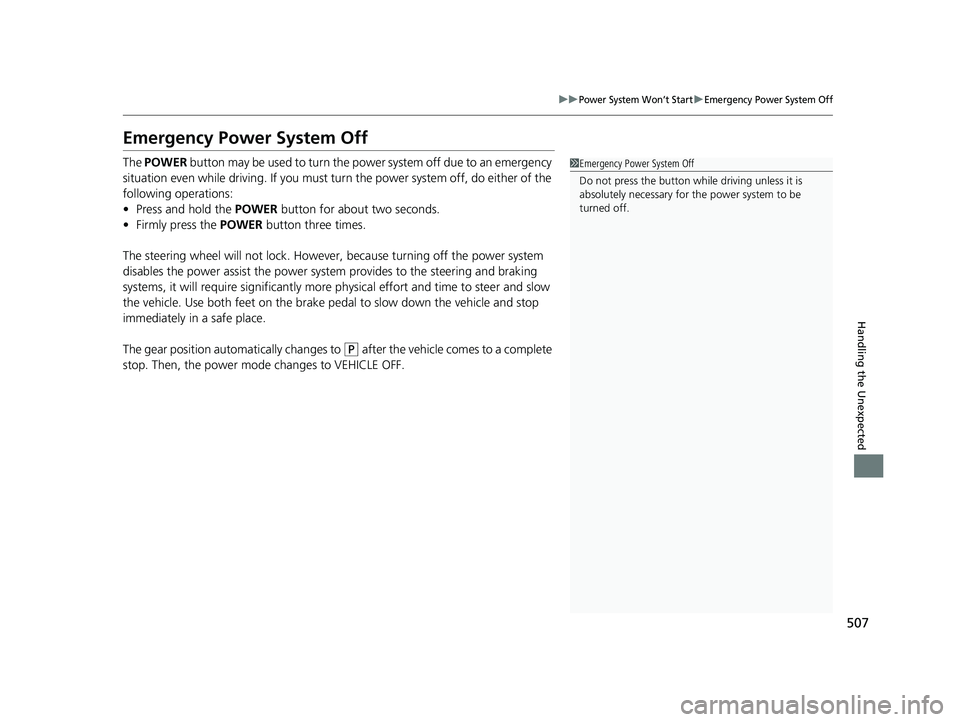
507
uuPower System Won’t StartuEmergency Power System Off
Handling the Unexpected
Emergency Power System Off
The POWER button may be used to turn the power system off due to an emergency
situation even while driving. If you must tu rn the power system off, do either of the
following operations:
• Press and hold the POWER button for about two seconds.
• Firmly press the POWER button three times.
The steering wheel will not lock. However, because turning off the power system
disables the power assist the power syst em provides to the steering and braking
systems, it will require significantly more physical effort and time to steer and slow
the vehicle. Use both feet on the brake pe dal to slow down the vehicle and stop
immediately in a safe place.
The gear position automatically changes to
(P after the vehicle comes to a complete
stop. Then, the power mode changes to VEHICLE OFF.
1 Emergency Power System Off
Do not press the button while driving unless it is
absolutely necessary for the power system to be
turned off.
21 CLARITY FCV CSS-31TRT6400_02.book 507 ページ 2020年9月25日 金曜日 午 後3時15分